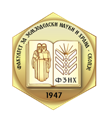SIMULATION OF WATER CONSUMPTION, GROWTH AND YIELD OF TOMATOES USING THE AQUACROP MODEL
Keywords:
irrigation, water consumption, tomato.Abstract
Water for irrigation will undoubtedly be reduced as a result of climate change, disrupted rainfall patterns, and water scarcity, putting crop production in jeopardy. As a result, in order to maintain high agricultural production and meet food demand, new technology must be developed, and the feasibility of cultivating essential vegetable crops without irrigation must be investigated. The goal of this research is to estimate tomato water consumption, growth, and yield using the Aquacrop model. The experiment was put up on carbonate chernozem soil near Stara Pazova (40 kilometers north of Belgrade). There were two treatments: soil treated with organic fertilizer Fertigkompost (OF) and soil treated with no organic fertilizer (K). Both treatments were fed by rain. The obtained results show that the AquaCrop model accurately predicts tomato yields with variations of 7.1 percent and 11.8 percent, respectively, when compared to observed yields on OF and K treatments. For the OF and K treatments, statistical indices of correlation coefficients (r) of 0.97 and 0.95, respectively, root mean square error (RMSE) of 10.1 percent, 9.0 percent, and Willmott index of agreement (d) of 0.98, 0.97, confirm excellent assessment of tomato growth. Water consumption is likewise fairly predicted by the model, with r= 0.72 and 0.63, RMSE = 38.1 and 32.5 mm, and d= 0.83 and 0.76 for the OF and K treatments, respectively. With high confidence, the model may be used to estimate tomato production in a variety of growth circumstances.



